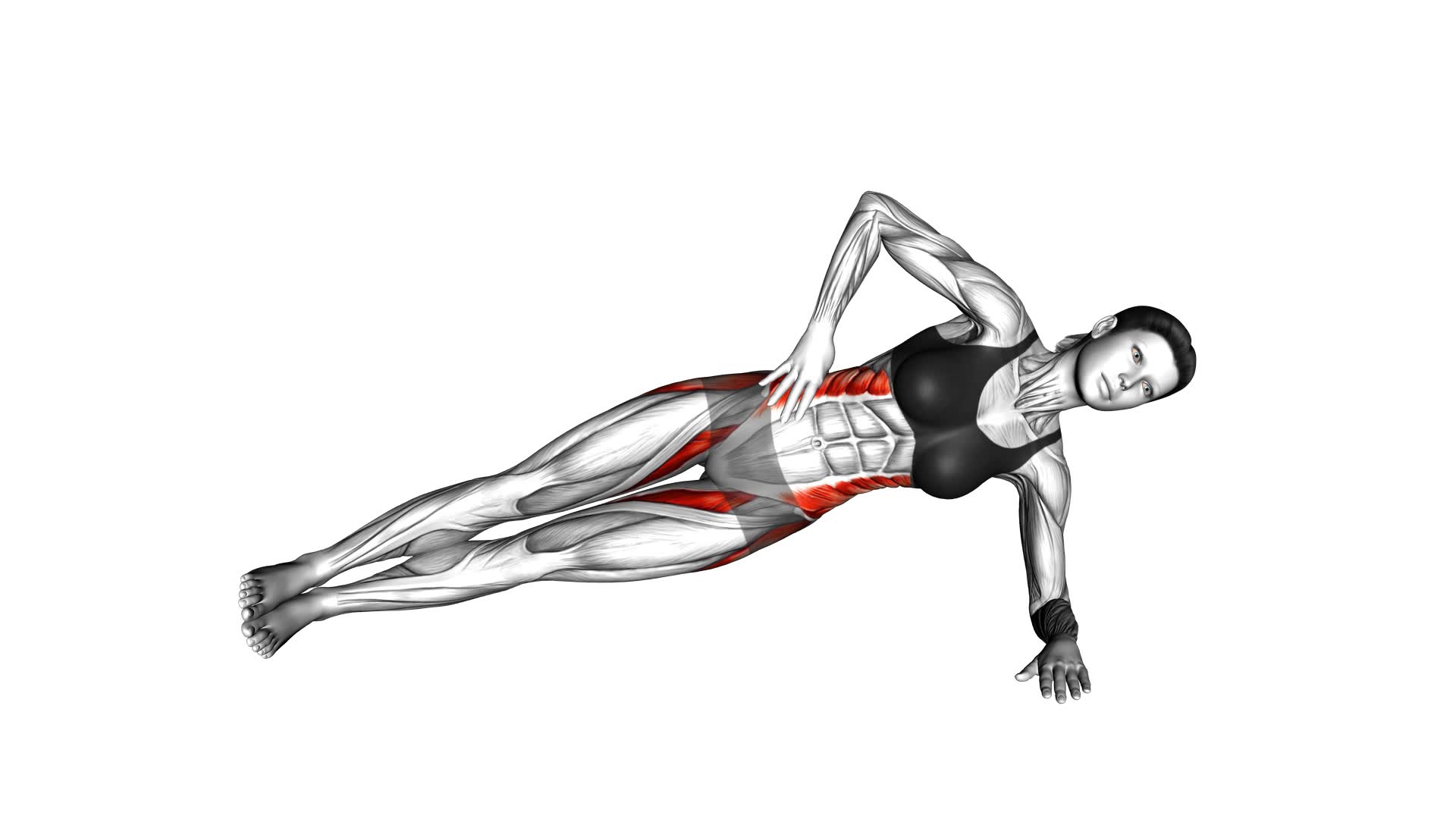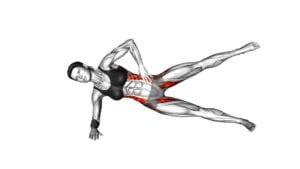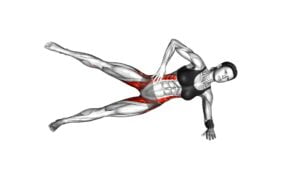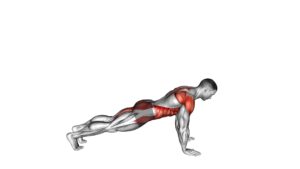Side Plank (VERSION 2) (female) – Video Exercise Guide & Tips

Are you looking to strengthen your core and tone your obliques?
Watch This Exercise Video
Then you need to try Side Plank (Version 2)!
In this video exercise guide, we'll show you the proper form and alignment for the female version of this challenging move.
We'll also give you tips on modifications and progressions, as well as common mistakes to avoid.
Get ready to take your fitness routine to the next level with Side Plank (Version 2)!
Key Takeaways
- Side plank exercise strengthens core muscles, including obliques, transverse abdominis, and lower back.
- Side plank improves stability, balance, and overall body strength.
- Side plank enhances muscle tone.
- Side plank helps prevent lower back pain.
Benefits of Side Plank (VERSION 2) for Females
Experience the amazing benefits of Side Plank (VERSION 2) to strengthen your core muscles and improve overall stability and balance. Side Plank (VERSION 2) is an effective exercise that targets your obliques, transverse abdominis, and glutes, helping you achieve your weight loss goals. This variation of the traditional Side Plank adds an extra challenge by lifting your top leg off the ground, engaging your muscles even more.
By incorporating Side Plank (VERSION 2) into your fitness routine, you won't only burn calories but also build lean muscle mass. This exercise engages multiple muscle groups simultaneously, leading to improved muscle tone and definition. Additionally, Side Plank (VERSION 2) helps improve your posture and spinal alignment, reducing the risk of back pain and injuries.
For advanced fitness levels, there are variations of Side Plank (VERSION 2) that you can try. One variation is the Side Plank with leg lift, where you lift your top leg and hold it in the air for a few seconds before lowering it back down. Another variation is the Side Plank with hip dip, where you lower your hips towards the ground and then lift them back up. These variations increase the intensity of the exercise, challenging your muscles even further.
Proper Form and Alignment for Side Plank (VERSION 2)
To perform Side Plank (VERSION 2) with proper form and alignment, focus on engaging your core muscles and maintaining a straight line from your head to your heels. This exercise is a more advanced variation of the traditional side plank and offers additional challenges for your core strength and stability.
Start by lying on your side with your legs extended and stacked on top of each other. Place your forearm on the ground directly under your shoulder, keeping your elbow in line with your shoulder. Press through your forearm and lift your hips off the ground, coming into a side plank position.
Engage your core by pulling your belly button in towards your spine, and make sure your body forms a straight line from your head to your heels. Avoid sagging or rounding your lower back. Keep your neck in line with your spine, looking straight ahead or slightly down. Hold this position for the desired amount of time, then switch sides.
To add variation, you can lift your top leg and hold it parallel to the ground, or you can perform a side plank with a leg lift, raising your top leg up and down while maintaining the side plank position. These advanced side plank variations will further challenge your core stability and increase the intensity of the exercise.
Modifications and Progressions for Side Plank (VERSION 2)
To modify or progress the Side Plank (VERSION 2) exercise, you can adjust the positioning of your feet or incorporate additional movements to challenge your core stability even further.
Here are some variations of Side Plank (VERSION 2) for different fitness levels:
- Feet positioning: You can modify the exercise by placing your top foot in front of your bottom foot for added stability. Conversely, you can progress the exercise by stacking your feet on top of each other, increasing the demand on your core muscles.
- Hip dips: To further challenge your core stability, you can incorporate hip dips into the Side Plank (VERSION 2) exercise. Lower your hip towards the floor and then lift it back up, focusing on maintaining proper alignment and engaging your obliques.
- Leg lifts: Another progression for Side Plank (VERSION 2) is to lift your top leg while maintaining the plank position. This targets not only your core muscles but also your hip abductors and glutes, adding an extra level of difficulty.
Remember to listen to your body and choose the modification or progression that suits your fitness level. By adjusting the positioning of your feet and incorporating additional movements, you can continuously challenge your core stability and progress in your Side Plank (VERSION 2) practice.
Common Mistakes to Avoid in Side Plank (VERSION 2)
Now, let's delve into some common mistakes to avoid when performing Side Plank (VERSION 2) to ensure maximum effectiveness and prevent injury.
One common mistake is allowing your hips to sag or lift too high. It's important to maintain a straight line from your head to your heels throughout the exercise.
Another mistake is placing too much weight on your supporting arm, which can strain your shoulder and wrist. To avoid this, distribute your weight evenly between your forearm and your feet.
Additionally, avoid holding your breath during the exercise. Remember to breathe deeply and continuously to maintain proper oxygen flow and prevent muscle tension.
Lastly, be cautious of overdoing it and pushing yourself too hard. Start with the basic version of Side Plank (VERSION 2) and gradually progress to more challenging variations and modifications as your strength and stability improve.
Tips for Getting the Most Out of Side Plank (Version 2)
To maximize your results and improve your performance, focus on the following tips when performing Side Plank (Version 2):
- Side plank variations for advanced practitioners:
Once you have mastered the basic side plank, challenge yourself by incorporating variations into your routine. Try lifting your top leg while maintaining the side plank position, or add a twist by reaching your top arm underneath your body and extending it towards the ceiling. These variations will engage different muscles and intensify the exercise.
- Incorporating side plank into a full body workout routine:
Don't limit side plank to just an isolated exercise. To get the most out of it, incorporate it into a full body workout routine. Pair it with other core exercises like planks or Russian twists, and combine it with upper and lower body exercises for a comprehensive workout. This will help you strengthen your entire body and improve overall stability.
- Focus on proper form and alignment:
To maximize the benefits of side plank, it's crucial to maintain proper form and alignment. Keep your body in a straight line from head to toe, engage your core muscles, and avoid sagging or rounding your shoulders. Additionally, make sure to breathe steadily throughout the exercise to oxygenate your muscles and enhance endurance.
By following these tips, you can take your side plank practice to the next level, challenge your muscles, and incorporate it into a well-rounded full body workout routine.
Remember to always listen to your body and adjust the intensity as needed to avoid injury and achieve optimal results.
Frequently Asked Questions
How Many Calories Can Be Burned by Doing Side Plank (Version 2) for Females?
Doing side plank (version 2) is a great exercise for weight loss and toning abs. It can help you burn calories and strengthen your core muscles. By engaging your obliques and stabilizing your body, you'll be working hard to maintain proper form.
This exercise is especially effective for females looking to target their abdominal muscles and improve overall fitness. Incorporate side plank (version 2) into your routine for a challenging and effective workout.
Can Side Plank (Version 2) Help in Reducing Waist Size?
Side plank (version 2) is a great exercise for reducing waist size. By engaging your core muscles, this variation of side plank targets the obliques, helping to tone and strengthen your waistline. Compared to traditional side plank, version 2 adds an extra challenge by lifting the top leg, increasing the intensity and effectiveness of the exercise.
Incorporating side plank (version 2) into your full body workout routine can provide numerous benefits, such as improved balance, stability, and overall core strength.
What Are the Different Variations of Side Plank (Version 2) That Can Be Done?
To vary your side plank (version 2) routine, try these different variations for females:
- The knee supported side plank
- The side plank with leg lift
These exercises target your core muscles and help strengthen your obliques and waist. By incorporating these variations into your workout, you can challenge your body in different ways and continue to see progress in reducing your waist size.
Keep up the good work!
How Long Should One Hold the Side Plank (Version 2) Exercise?
To get the maximum results from the side plank (version 2) exercise, it's important to know how long to hold it.
The duration of the side plank (version 2) can vary depending on your fitness level and goals.
Beginners may start with 10-15 seconds and gradually increase the time as they get stronger.
Advanced individuals can aim for 30-60 seconds or even longer.
Can Side Plank (Version 2) Help in Improving Core Strength for Other Exercises?
Side plank (version 2) is an effective exercise for improving core strength, which can benefit your overall fitness. By engaging your abdominal and oblique muscles, it helps to stabilize your entire body.
To incorporate side plank (version 2) into your full body workout routine, you can perform it as part of a circuit or include it as a core exercise between sets of other exercises. This will help you develop a strong core foundation for other exercises and enhance your overall strength and stability.
Conclusion
In conclusion, incorporating side plank (version 2) into your exercise routine can provide numerous benefits for females.
It helps strengthen the core, improve balance, and tone the obliques.
By maintaining proper form and alignment, avoiding common mistakes, and making necessary modifications, you can maximize the effectiveness of this exercise.
Remember to engage your core, breathe deeply, and listen to your body's limits.
Adding side plank (version 2) to your fitness regimen can contribute to a stronger and more balanced physique.

Author
Years ago, the spark of my life’s passion ignited in my mind the moment I stepped into the local gym for the first time. The inaugural bead of perspiration, the initial endeavor, the very first surge of endorphins, and a sense of pride that washed over me post-workout marked the beginning of my deep-seated interest in strength sports, fitness, and sports nutrition. This very curiosity blossomed rapidly into a profound fascination, propelling me to earn a Master’s degree in Physical Education from the Academy of Physical Education in Krakow, followed by a Sports Manager diploma from the Jagiellonian University. My journey of growth led me to gain more specialized qualifications, such as being a certified personal trainer with a focus on sports dietetics, a lifeguard, and an instructor for wellness and corrective gymnastics. Theoretical knowledge paired seamlessly with practical experience, reinforcing my belief that the transformation of individuals under my guidance was also a reflection of my personal growth. This belief holds true even today. Each day, I strive to push the boundaries and explore new realms. These realms gently elevate me to greater heights. The unique combination of passion for my field and the continuous quest for growth fuels my drive to break new ground.







